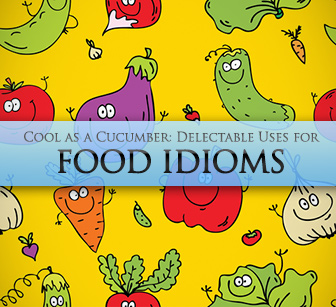
Idioms in general are a momentous and exciting development in every learner's experience.
Food idioms provide substance everyone can relate to and enjoy. Your students will definitely devour these delectable uses for food idioms.

How to Teach Food Idioms
-
1
Illustrate Literal Meanings
When starting out, students will be chomping at the bit to learn any idioms, so it is best to choose a topic that is easy to digest. Food idioms are the perfect choice, introducing them incrementally is essential. A playful way to get students in tune with how idioms are used is to first take them literally. Give student a list of food idioms and ask them to illustrate the literal meanings. Doing this will help them to define the idiom first in their own terms, and then move into exploring how to apply idiomatic phrases in natural language.
Begin with a handful or so of your favorite food idioms that you think would be fairly easy to define with a drawing. A few good ones to start out with might be:
- Have Egg on Your Face
- Drink Like a Fish
- Easy as Pie/Piece of Cake
- Walk on Eggshells
- Butter Up
These are all good choices to have the students illustrate. You can devise this activity in a number of ways, but you want to be sure that it incorporates language and actual usage of the idioms. Explain the difference between literal and figurative language, and then ask them to create drawings that illustrate the literal meaning of the food idioms. Once they have done so, you can have them write humorous captions that capture the meaning of the drawing and explains the use of the expression. Having the illustrations will serve as a memorable way for students to remember what the idioms mean, and how best to use them correctly.
-
2
Use Stories to Illustrate Meaning
Get your own creative juices flowing and whip up a short story that has ten to fifteen food idioms sprinkled into the text. Students should locate all the idioms and then they can attempt to figure out the figurative meanings in context. This exercise is a wonderful comprehension check because it involves discussion of what the idioms mean, and appropriate ways to use them. It is a good idea to add in a few difficult expressions along with several that are well-illustrated throughout your story. After they have had some discussion time, you may want to give them some fill-in-the-blank exercises or comprehension questions that incorporate the idiomatic definitions. However you would like, creating your own story gives flavor to your idioms, and your students will enjoy your composition. Here is a very short example:
John's dad came home one afternoon and said he could no longer bring home the bacon. His Dad said, “I lost the job that I never liked, and now I just went from the frying pan into the fire.” John told his father he must make his bread and butter doing something he really loved to do. That way work doesn't quite feel so much like work. His dad took his advice, buttered up Steve Jobs and got a job creating iPhone apps. His dad told John it wasn't easy working at a new job, but he had no problem remaining as cool as a cucumber under the pressure.
You can be as silly or obvious as you like, and provide more detail than this example. You can also have students write their own creative stories utilizing a few idioms and sharing their writing with the class.
-
3
Situational Examples
Situational examples are generally necessary when it comes to introducing and defining any idioms, and food idioms can be extraordinarily entertaining. Begin with a list of very common food idioms that students might have heard before. Test the waters, and put a few of them on the board. Ask the students if they have heard the idioms and if so could they provide an example of how to use it. From there provide idioms they have not heard before and give them a few anecdotal examples to demonstrate the idioms. Be sure to do a lot of comprehension checks as you go, and don't move too fast through your examples. Once you have given them a number of situational examples, and they are getting into it, challenge students to provide their own examples for the idioms they have learned. You can do this in pairs or groups, so long as the students are creating original examples and not just copying yours. To focus on food idioms specifically, you can apply the challenge that their examples must be in regards to cooking, the kitchen, or dining out. This makes creating their examples more challenging and memorable. An example could be: Our waiter was very charming, and even gave us a free dessert. He was definitely the cream of the crop. Some examples will be short like this one, but others may require more explanation. If you want to make it into a game, get out your timer and have students provide situational examples before the timer runs out. Students enjoy learning what idioms mean, but they also appreciate direction on how to insert them into conversation naturally. It's an important step to make sure they use idioms correctly and that they don't overuse them.
Introducing and practicing food idioms can really make students' mouths water for more and more exposure to idioms.
Keep the flavor coming, and give them plenty of fat to chew on with these delectable food idiom uses!
P.S. If you enjoyed this article, please help spread it by clicking one of those sharing buttons below. And if you are interested in more, you should follow our Facebook page where we share more about creative, non-boring ways to teach English.







